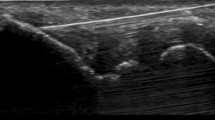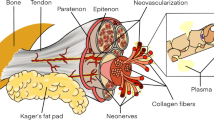Abstract
Sclerosing polidocanol injections targeting the area with neovessels (vascularity) have been demonstrated to give promising clinical results in patients with chronic painful Achilles and patellar tendinosis. Recently, we demonstrated vascularity in the extensor origin in patients with chronic painful tennis elbow, but not in controls with pain-free elbows. In this pilot study, 11 patients (four men and seven women, mean age 46 years) with the diagnosis of tennis elbow in altogether 13 elbows, were included. All patients had a long duration of pain symptoms (mean 23 months), and ultrasonography (US) + colour Doppler (CD) examination showed structural tendon changes with hypo-echoic areas, and a vascularity, corresponding to the painful area in the extensor origin. All patients were treated with US- and CD-guided injections of the sclerosing substance polidocanol, targeting the area with vascularity. At 8-month follow-up after treatment, there was a good clinical result in 11/13 elbows. Extensor origin pain during wrist loading activities (recorded on a VAS-scale) was significantly reduced (mean VAS from 75 to 34; P < 0.003), and maximal grip strength was significantly increased (from 29 to 40 kg; P < 0.025). Our findings indicate that one treatment with sclerosing polidocanol injections, targeting the area with vascularity in the extensor origin, has a potential to reduce the tendon pain and increase grip strength, in patients with chronic painful tennis elbow.



Similar content being viewed by others
References
Alfredson H, Ljung BO, Thorsen K, Lorentzon R (2000) In vivo investigation of ECRB tendons with microdialysis technique—no signs of inflammation but high amounts of glutamate in tennis elbow. Acta Orthop Scand 71:475–479
Alfredson H, Öhberg L, Forsgren S (2003) Is vasculo-neural ingrowth the cause of pain in chronic Achilles tendinosis? An investigation using ultrasonography and colour Doppler, immunohistochemistry, and diagnostic injections. Knee Surg Sports Traumatol Arthrosc 11:334–338
Alfredson H, Öhberg L (2005a) Neovascularisation in chronic painful patellar tendinosis-promising results after sclerosing neovessels outside the tendon challenge the need for surgery. Knee Surg Sports Traumatol Arthrosc 13:74–80
Alfredson H, Öhberg L (2005b) Sclerosing injections to areas of neo-vascularisation reduce pain in chronic Achilles tendinopathy: a double-blind randomised controlled trial. Knee Surg Sports Traumatol Arthrosc 13:338–344
Assendelft WJ, Hay EM, Adshead R, Bouter LM (1996) Corticosteroid injections for lateral epicondylitis: a systematic overview. Br J Gen Pract 46:209–216
Bisset L, Paungmali A, Vicenzino B, Beller E (2005) A systematic review and meta-analysis of clinical trials on physical interventions for lateral epicondylalgia. Br J Sports Med 39:411–422
Bjur D, Alfredson H, Forsgren S (2005) The innervation pattern of the human Achilles tendon: studies of the normal and tendinosis tendon with markers for general and sensory innervation. Cell Tissue Res 320:201–216
Buchbinder R, Green S, Bell S, Barnsley L, Smidt N, Assendelft WJ (2002) Surgery for lateral elbow pain. Cochrane Database Syst Rev CD003525
Cook JL, Malliaras P, De Luca J, Ptasznik R, Morris M (2005) Vascularity and pain in the patellar tendon of adult jumping athletes: a 5 month longitudinal study. Br J Sports Med 39:458–461
Coonrad RW, Hooper WR (1973) Tennis elbow: its course, natural history, conservative and surgical management. J Bone Joint Surg Am 55:1177–1182
De Smet L, Van Ransbeeck H, Fabry G (1998) Grip strength in tennis elbow: long-term results of operative treatment. Acta Orthop Belg 64:167–169
Forsgren S, Danielson P, Alfredson H (2005) Vascular NK-1 receptor occurrence in normal and chronic painful Achilles and patellar tendons: studies on chemically unfixed as well as fixed specimens. Regul Pept 126:173–181
Fridén J, Lieber RL (1994) Physiologic consequences of surgical lengthening of extensor carpi radialis brevis muscle–tendon junction for tennis elbow. J Hand Surg Am 19:269–274
Goldie I (1964) Epicondylitis lateralis humeri (epicondylalgia or tennis elbow). A pathogenetical study. Acta Chir Scand Suppl 339:1–119
Green S, Buchbinder R, Barnsley L, Hall S White M, Smidt N, Assendelft W (2002) Non-steroidal anti-inflammatory drugs (NSAIDs) for treating lateral elbow pain in adults. Cochrane Database Syst Rev CD003686
Hayton MJ, Santini AJ, Huges PJ, Frostick SP, Trail IA, Stanley JK (2005) Botulinum toxin injection in the treatment of tennis elbow. A double-blind, randomized, controlled, pilot study. J Bone Joint Surg Am 87:503–507
Kahn KM, Cook JL, Maffulli N, Kannus P (2000) Where is the pain coming from in tendinopathy? It may be biochemical, not only structural, in origin. Br J Sports Med 34:81–83
Lieber RL, Ljung BO, Fridén J (1997) Sarcomere length in wrist extensor muscles. Changes may provide insights into the etiology of chronic lateral epicondylitis. Acta Orthop Scand 68:249–254
Ljung BO, Forsgren S, Fridén J (1999) Substance P and calcitonin gene-related peptide expression at the extensor carpi radialis brevis muscle origin: implications for the etiology of tennis elbow. J Orthop Res 17:554–559
Nirschl RP (1992) Elbow tendinosis/tennis elbow. Clin Sports Med 11:851–870
Öhberg L, Alfredson H (2002) Ultrasound guided sclerosis of neovessels in painful chronic Achilles tendinosis: pilot study of a new treatment. Br J Sports Med 36:173–177
Öhberg L, Alfredson H (2003) Sclerosing therapy in chronic Achilles tendon insertional pain—results of a pilot study. Knee Surg Sports Traumatol Arthrosc 11:339–343
Regan W, Wold LE, Coonrad R, Morrey BF (1992) Microscopic histopathology of chronic refractory lateral epicondylitis. Am J Sports Med 20:746–749
Torp-Pedersen T, Torp-Pedersen S, Bliddal H (2002) Diagnostic value of ultrasonography in epicondylitis. Ann Intern Med 136:781–782
Zeisig E, Öhberg L, Alfredson H (2006) Extensor origin vascularity related to pain in patients with tennis elbow. Knee Surg Sports Traumatol Arthrosc March 23; E-pub before print
Acknowledgments
Funding for the study has been achieved through the Swedish Research Council for Sports.
Author information
Authors and Affiliations
Corresponding author
Rights and permissions
About this article
Cite this article
Zeisig, E., Öhberg, L. & Alfredson, H. Sclerosing polidocanol injections in chronic painful tennis elbow-promising results in a pilot study. Knee Surg Sports Traumatol Arthrosc 14, 1218–1224 (2006). https://doi.org/10.1007/s00167-006-0156-0
Received:
Accepted:
Published:
Issue Date:
DOI: https://doi.org/10.1007/s00167-006-0156-0




